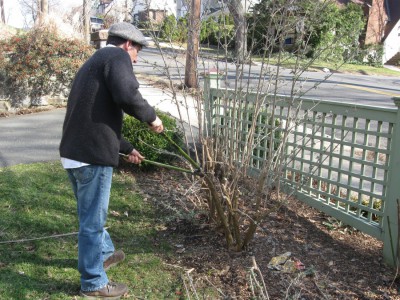 It’s official. Once we set our clocks forward there is no going back. The March march back out into the garden has begun. Bulbs are up, rose buds are swelling, and maples are starting their annual debris drop. Yes, Virginia there is a spring.
It’s official. Once we set our clocks forward there is no going back. The March march back out into the garden has begun. Bulbs are up, rose buds are swelling, and maples are starting their annual debris drop. Yes, Virginia there is a spring.
By Chris Cohan
 It’s official. Once we set our clocks forward there is no going back. The March march back out into the garden has begun. Bulbs are up, rose buds are swelling, and maples are starting their annual debris drop. Yes, Virginia there is a spring.
It’s official. Once we set our clocks forward there is no going back. The March march back out into the garden has begun. Bulbs are up, rose buds are swelling, and maples are starting their annual debris drop. Yes, Virginia there is a spring.
However, this year it is more like Pat, the “Saturday Night Live” character, a gender ambiguous person who could be the anthropomorphism of this spring. Winter was a wimp. The obvious change in seasons this year is about as discernible as Pat’s gender.
Ignore the blurry change of seasons, be definite, and get your garden in shape. First, clean, oil, and sharpen your tools. Then recycle all old metal tools that are cheap and make gardening a chore. Who makes these junky tools anyway? Could it be a conspiracy by unnamed foreign interests to terrorize and frustrate American gardeners? Even more curious is why so many people keep buying them? Doing the same thing over and over again and expecting a different outcome is a definition of insanity. Somehow, for some reason, some believe that this time it will be different and the cheap tools will work well and last. Not a chance.
I have never been a status symbol seeker or name brand devotee. However, when it comes to gardening tools, I buy the best. They last a lifetime and make gardening a joy.
Before leaves fully emerge it’s easier to observe the architecture of your plants. Take this opportunity to start pruning. Cut off all weak, damaged, and dead branches. Then prune shrubs to shape. Remove any crossing branches.
Get tough with butterfly bushes. Many may reach up to six feet in height. Cut them back to the old wood, around two feet off the ground. Pruning reduces the chance for a top-heavy plant to split or topple over and promotes lots of new flowering growth and stimulates many new flowering branches.
Spirea and caryopteris also bloom on new wood, and should be cut back by half.
This time of year, most catmint resembles sad gray clumps of death. But beneath that false façade lurks a super-charged long-blooming rascal, which is ready to start rapidly producing handsome gray leaves and blue flowers. Grab the dead clump like the hair on a witch doctor’s shrunken head. Then, with a few quick clips, reduce it to a tidy circle revealing some modest fresh growth.
While rustling in the winter wind, ornamental grass tassels gave your garden height and interest. Now is the time to say thank you to withered grasses for their cold weather effort and cut them back. Use electric hedge clippers for the bigger ones. The dried grass is great as a fire starter and mulch. After pruning, consider transplanting the humongous ones that have overtaken their space and dwarfed neighboring plants.
Transplant in whole or divide and spread out to the back of the border or other locations where they may flourish. The smaller grasses can be divided and spread out as well. This is the best time to handle grasses; they are resilient, and while dormant will almost always survive.
The mild winter allowed many pests to keep doing their damaging work. To get them and give your plants a fighting chance, apply horticultural oil. The oil suffocates the insects. It is highly refined (as if we would allow an unrefined oil in our community), and evaporates quickly, leaving no trace in your garden. While no guarantees are promised, this is the simplest task to ensure successful organic gardening.
Turn over the vegetable garden. Clean, rake, and enjoy the Zen-like beauty of the dark, rich freshly raked soil. Take in the peace and solitude of a placid garden patch before the onslaught of the growing season. This is the most exciting time of year for gardeners.















